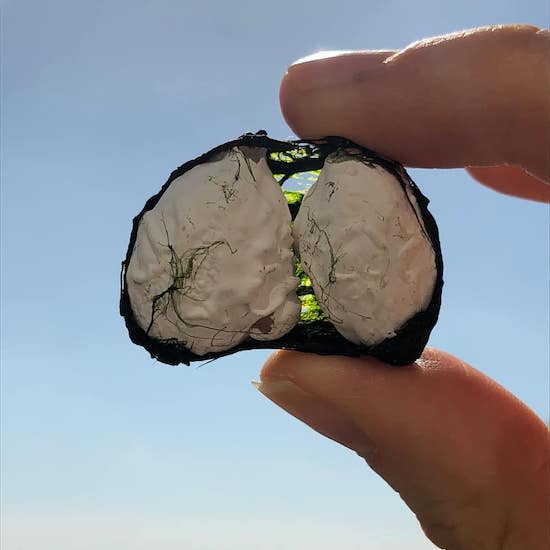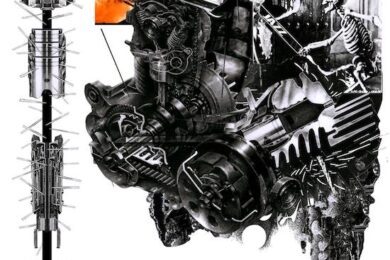Picture credit: ‘My breath in your hands’. Porcelain and algae by Venetia Nevill
Miniscule Venice is the second of two large group exhibitions of miniature works, this one featuring work by over 200 internationally established and emerging artists. The first took place at Cross Lane Projects in Kendal, Cumbria, a project space founded in 2018 by artists Rebecca Scott and Mark Woods. Participant-identified countries include Guatemala, Kazhakstan, Mexico, Russia, and Slovenia.
Vanya Balogh curates not only art but artists, drawing an extended group of artist-maker-performers for diverse exhibitions in London and internationally, organising themed and open themed shows, and is adept at working with large numbers of participants. The particular genesis for the Miniscule show occurred in the mid-80s at St Martins School of Art with fellow artist-student Jim Racine. The lack of studio space was frustrating so the two devised the idea to use a huge metal drum containing hundreds of miniature sculptures and art pieces, then roll this round the streets of London. In 2010 this original aborted idea gave birth to the exhibition Miniscule at the Oblong Gallery on Southgate Road. With Miniscule 1 (Kendal, Cumbria) and Miniscule 2 (Venice, Italy) the idea has morphed into these two large exhibitions.
Many of the artists taking place are new to working in miniature. Some have been inspired to produce many new pieces coming out of this endeavour, series now waiting for showcase opportunities. Others – myself included – did not find the challenge easy and I am not the only participant to have backed off or dropped out, left on the sidelines to appreciate the scale and marvel at the complexity of this operation as outsiders.
Most of the works are handmade, some with the help of optical tools such as the magnifying glass. Many artists have taken aspects of their work and scaled this down to fit the exhibition.
Balogh says, “controlling tiny scaled-down worlds can give us new perspectives, restore our sense of order in uncertain times and in unexpected ways let us see our world in a whole new light. Is an object to be judged by its size? Does size really matter? Can we say that the London Eye has more impact on the art world than a bicycle wheel?” To alter our scale is disconcerting, as Alice complained in Wonderland “I’m not particular as to size, only one doesn’t like changing so often, you know.” Children take to miniature art, with innumerable stories attractive to child readers that feature tiny protagonists in an ordinary size world such as Mary Norton’s The Borrowers (1952) or the original political satire which uses size, Jonathan Swift’s Gulliver’s Travels (1726). In this exhibition some of the children of participating artists are also taking in what has become a cross-generational exhibition.
Extinction Rebellion and related art protest against unecological human policy is on the minds of many artists from this ad hoc collective. Balogh is a supporter and unofficial campaigner for environmental causes. Perhaps working in miniscule can be construed as a way in which artists can use less resources. I don’t know. But I’m considering the implications of working small and that’s what such a show should do, make us think.
Doug Haywood and Venetia Nevill have both incorporated eco-concepts and materials into their work. Haywood’s work uses cress seed and the piece needs to be cared for (watered) during the duration of the show, incorporating concepts of regeneration and eco-management. Haywood outlines his piece, Burgeon as a mini oasis of life in a ceramic dish. “Mixed seeds are set to germinate at the time of the show’s launch next week. The shoots will grow if cared for in its microclimate and the conditions are right. In effect, this is a small world that reflects the fragility of our one and only, larger Earth. The impending growth of the plants will not only be a battle of species and living space but also challenge the rule that works be no larger than 50mm. The piece has the potential to outgrow its restraints.”
Nevill’s piece, My breath in your hands (porcelain and algae) investigates the repurposing of natural materials for art, materials that intrigue her for diverse reasons. She celebrates algae for its healing and transformative qualities. he shape for the ceramic was achieved through using tiny balloons to mimic two lung luck shapes. These white sacs are encased in an algae nest. The contrasting elements referencing the symbiotic relationship between animal and plant in oxygenation. Nevill is conscious of the potential for algae as an economical food and renewable energy source and her work is deliberately referencing the possible function of plants to sustain human life in its contested future.
A significant proportion of artists have worked with found materials. One of these is Jessica Bailey’s piece ‘Found; Reunited and Empowered’, one of many pieces that use a matchbox as a basis. Her piece has a characteristic iridescent shimmer. Within a silver antique matchbox she incorporates a quote from Gandhi taken from a page of the National Geographic magazine: “a small body of determined spirits fired by an unquenchable faith in their mission can alter the course of history.”
Gandhi has become a controversial figure through his unethical exploitation of young women, taking advantage of his position as leader, asking his grandniece and devotee to sleep with him but his eccentric experiments have not undermined his position as a leading philosopher and agitator to many. How far this may change now his personal practices are no longer hushed up and have become public is yet to be seen. One difficulty with using found material is that art may acquire new meanings that the maker did not intend when setting out to make a piece. It can be a risky business.
Artists already working in complicated detailed work have found the challenge a more comfortable opportunity to develop a piece. Sculptor Thomas J. Ridley’s piece Someone Sleeping Rough is a wall mounted painted/patinated bronze, a figure in a green sleeping bag, laid down inside a matchbox. The attention and craft is undeniable. The figurine has blue denim and dark trainers. He is lifelike, though necessarily very, very small and the scale and setting give him a fairytale effect, like a mash-up of Thumbelina and The Little Match Girl.
Also working with the body but with parts are Riitta Hakkarainen and Alice Herrick, Herrick moulding a torso in polymer clay, Hakkarainen repurposing already existing work from a series of cast resin. Both artists chose in different ways to depict torsos from female nudes, offering two new takes on the broken statues from classical eras, revered in art education.
One of the sculptors in the show, Nancy Fouts, died from natural causes during the run up to the show. Fouts was known for her fine art work reconfiguring commonplace objects and was also outstanding and acclaimed designer for her work in advertising. She created seminal ad campaigns for Silk Cut, British Airways, Benson & Hedges and Virgin and designed album covers for bands including Manfred Man and Steeleye Span. Her sleeve for ‘Commoners Crown’ by Steeleye Span won the 1976 award for Best Designed British Album Sleeve. Fouts directed the artist-run gallery Fouts and Fowler which opened in 1989.
Including an artist known for advertising art, working on commercial scale stimulates us to contemplate the paradox at the centre of using art for eco-protest. This is appropriate. Miniscule is about and generating conversation as well as being about the work itself. In this way all the works, not just Haywood’s, outgrow Balogh’s enforced limits of scale.
Miniscule Part 2 is at the Fondamenta Sant’Anna, Venice, until 21 July 2019



